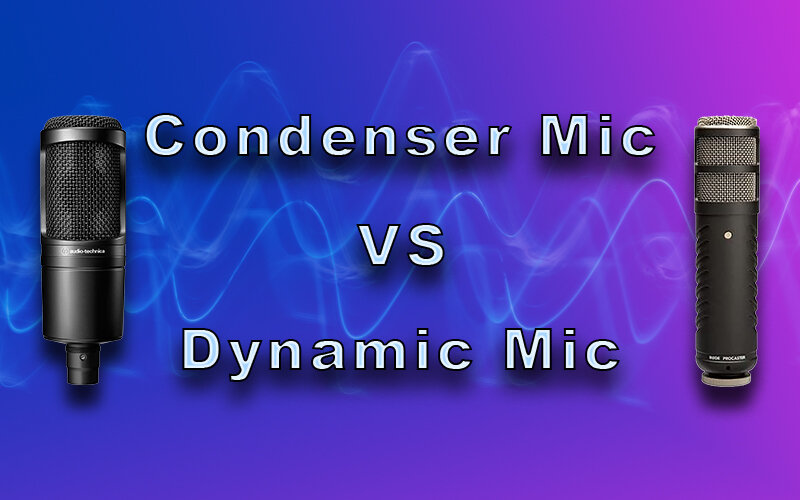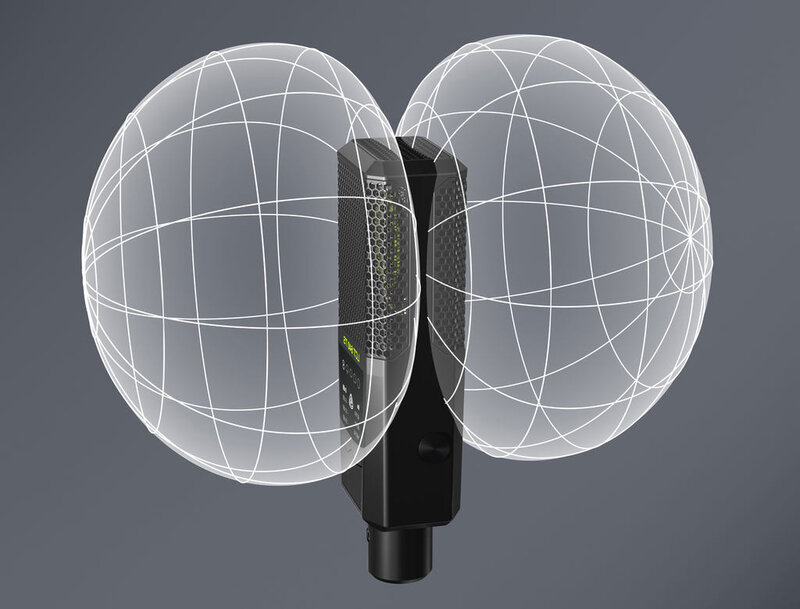Finding the right microphone for your streaming experience can be challenging, especially if you are unfamiliar with the specifications of condenser and dynamic microphones.
These two often differ significantly in various aspects, yet they also share some similar specifications that can make choosing between them quite challenging.
If you want to learn more about these microphones and find the right fit for you, please read our guide carefully!
Table of Contents
Condenser Mic vs Dynamic Mic – Ultimate Comparison

1. Active or Passive
Active microphones are those that require a significant power supply to operate, specifically condenser microphones.
They are always active, unlike dynamic microphones, which do not require any power to function effectively.
Active microphones require several components to function correctly, and you will need to learn how to handle vacuum tubes, capsules, printed circuit boards, impedance converters, and various other elements if you wish to use them.
In contrast, dynamic mics are significantly easier to manage, and because they operate on electromagnetic induction, there is no need to connect them to any form of phantom power.
The best dynamic microphones are those that are USB powered, as they are the easiest to use. All you need to do is connect them to your device and charge them when necessary.
Most dynamic microphones available today are USB powered, and they generally provide the best sound quality, which was not the case in the past.
2. Transducer Principle
This is the most significant difference between dynamic and condenser microphones, and it is the simplest way to distinguish between the two.
The primary difference is that dynamic mics convert energy solely through electromagnetic induction, whereas condenser mics operate based on electrostatic principles.
Dynamic mics operate by utilizing a conductor that moves through a changing magnetic field, a process essential for the microphone to generate a frequency response.
Some people refer to them as moving-coil microphones because they require a conductive coil to be attached at all times; otherwise, the sound waves will not reach it.
The moving coil and diaphragm of the microphone are always positioned at the center of the magnetic field, which creates a cylindrical cutaway.
When the diaphragm moves left and right, it generates a higher voltage across the coil, which then produces sound waves from your microphone.
On the other hand, we have condenser mics, which are electrostatic and function as a completely parallel capacitor.
The electrical leads are connected to both the front and backplate, and while they are fully movable, they must be secured to transmit the sound waves.
You can resolve this issue with phantom power or an external power supply, and essentially, any of the comparable options should work well with it.
By repositioning the capacitor while keeping it connected to the plates, a proportional voltage will be generated, resulting in the correct microphone signal.
3. Frequency Response
Many people prefer a condenser mic due to its perfectly flat frequency response, which allows for the creation of extended frequencies.
They can perfectly recreate real-life sounds, and when converting sound waves, they ensure that everything remains as realistic as possible.
For that reason, individuals who create podcasts or engage with their community through live streams utilize this type of microphone because they understand that when the sound waves reach their audience, everything will sound the same to them as it does to the creators.
However, if you are frequently moving and not paying attention to the audio interface for streaming, your audio quality may suffer, potentially becoming harsh at times. Therefore, ensure you avoid loud noises or sudden changes in your environment.
I recommend using small-diaphragm condensers, as they tend to produce more delicate sounds.
A dynamic mic has fairly limited performance, and its frequency response is often quite colored. Therefore, if you intend to use it for recording vocals or complex sounds, you should consider selecting a condenser mic or a specific mic designed for vocal recording.
Every dynamic mic I have ever used performed poorly, and when it came to louder sounds, the recording often distorted as it reached higher pitches. Therefore, I definitely don’t recommend it, especially if you are relying on this for income.
However, if you are using it solely to live stream your games and do not require exceptional or detailed sound, it will perform adequately.
4. Transient Response
Although most people are unaware of what it is, this is one of the most crucial features of every microphone.
A quality microphone must possess a good transient response; otherwise, the live sound will not sound natural, and you will be unable to transfer the sound waves in real-time.
Condenser mics consistently perform well because their diaphragm is lightweight and moves quickly, allowing it to respond to every sound wave in its environment.
This makes it an excellent choice for individuals recording podcasts or vocals, and it reduces self-noise.
Those with a smaller diaphragm are the most effective, as they deliver perfect higher frequencies.
However, a dynamic mic has a slow transient response and lacks accuracy, which can particularly cause issues with high-frequency sounds.
This recording device typically features a heavy and thick diaphragm that is inert and does not react when needed.
Their snare drum is good, particularly if they use a large-diaphragm condenser. However, it may struggle with loud sounds, and your vocal mic signal could come across as overly dramatic.
The oscillations are relatively high, and there is little you can do about that. Therefore, if this is important to you, I would always recommend choosing a condenser mic.
5. Polar Patterns
Polar patterns are essential for acoustic energy and sound quality, so you will need dynamic and condenser microphones that excel in managing these aspects.
A condenser mic can feature any polar pattern and may have one or two diaphragms simultaneously.

Manufacturers often combine various amplitudes in a single condenser microphone to produce multiple polar patterns.
Most condenser microphones available on the market today feature multiple polar patterns, which enables them to effectively capture loud sounds and high frequencies.
In contrast, dynamic microphones typically feature only one polar pattern, and their design is generally quite straightforward.
Depending on the dynamic microphone’s capsule, the voice coil can exhibit either an omnidirectional or unidirectional pattern.
Since one side of the diaphragm must have a fixed structure and magnetic coil, it is impossible to achieve multiple polar patterns simultaneously.
For that reason, I am always a much bigger fan of condenser microphones.
6. Durability
When considering dynamic and condenser microphones, you are evaluating which of these devices is more durable.
Although condenser microphones are generally more popular, dynamic microphones are much more durable and nearly unbreakable, regardless of the brand or price range.
Most condenser microphones are durable as well, but since their diaphragm moves frequently and is quite sensitive, I wouldn’t advise being too rough with it.
They contain vacuum tubes, which makes them quite fragile; if one of these tubes breaks, the sound quality will be significantly compromised.
Dynamic microphones feature a more rigid structure and are quite sturdy due to the magnetic field, so you won’t need to worry about them breaking easily.
They also lack any problematic components, so you don’t need to worry about something inside your dynamic microphones breaking without your notice.
7. Sound Pressure Levels
The maximum sound pressure level of your microphone determines whether the microphone signal will be distorted.
All condenser mics have a maximum sound pressure level, which refers to the highest point at which the mic signal begins to distort.
Dynamic microphones typically do not handle high sound pressure levels, if they can handle them at all, making them an unreliable choice.
The diaphragm of a dynamic mic cannot become overloaded, and these sound pressure levels are quite impractical, regardless of how you intend to use the dynamic mics.
8. Self Noise
All condenser microphones produce self-noise, whereas dynamic microphones do not.
All active condenser microphones contain various components that contribute to self-noise in the mic signal.
However, while all microphones generally have some level of noise floor, this is particularly insufficient in dynamic microphones, as they lack active components that would contribute noise to the microphone signal.
9. Sensitivity
The sensitivity indicates a microphone’s signal level at a specific sound pressure level.
All condenser mics are highly sensitive, making them the ideal choice for professionals or individuals working with acoustic guitars or a drum kit.
Their ribbon microphones function excellently as room mics and can ideally capture the sound of a bass drum.
However, even USB microphones that are dynamic mics will be sensitive to some degree, but they won’t produce excessively high output levels.
However, if you are deciding between a dynamic and a condenser microphone, I would say there is not a significant difference, unless you are using it for music purposes. If you need your acoustic guitar, bass drum, and ribbon mics to sound like a studio recording, then a condenser microphone is a much better investment.
Acoustic instruments perform best with a condenser mic, as it is the only device capable of effectively handling higher frequencies.
10. Price
Lastly, price is one of the most important factors people consider when choosing between dynamic and condenser microphones.
If you are still pondering whether a dynamic or condenser mic will prevail in this battle, I believe you will always choose a dynamic microphone.

Dynamic microphones typically start at around 10 dollars, and you can find excellent condenser microphones for under 30 dollars.
They may require phantom power, but they will be worth it in the long run, as there is no way they will cost you more than 100 dollars over years of use.
Conversely, you can find a large-diaphragm condenser microphone for 40 to 50 dollars; however, those in the lower price range are typically insufficient, and you will need to invest in a condenser microphone that costs over 100 dollars.
You will also need to invest in a condenser microphone capsule, which can be quite expensive.
If you are not a professional streamer or podcaster, I recommend getting a dynamic microphone. However, if you are serious about your future in the online community, a condenser mic is an investment that will definitely pay off in the long run.
Which One Is the Right Option for Streamers?
I always recommend a dynamic microphone to all streamers because it is much more affordable while still delivering good sound quality.
The quality of the sound may not be absolutely perfect, but it will certainly be good enough for live streams, allowing your viewers to keep up with you.
Additionally, you won’t need to invest in new components such as capsules or vacuum tubes, which will save you both time and money.
Dynamic microphones are much easier to use, and they perform well even without any additional programs or settings to enhance their functionality.
